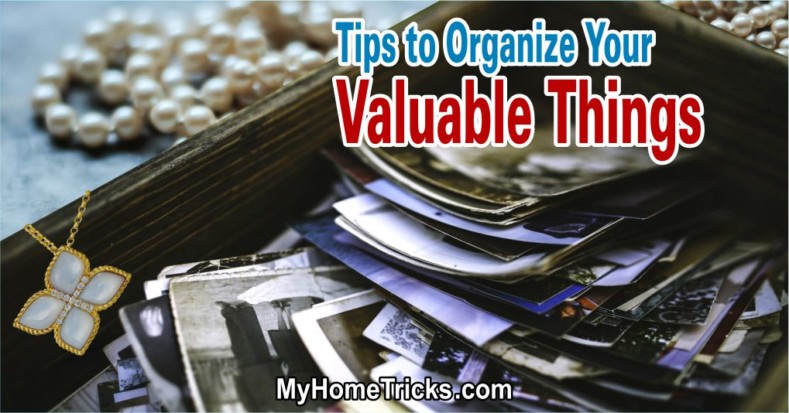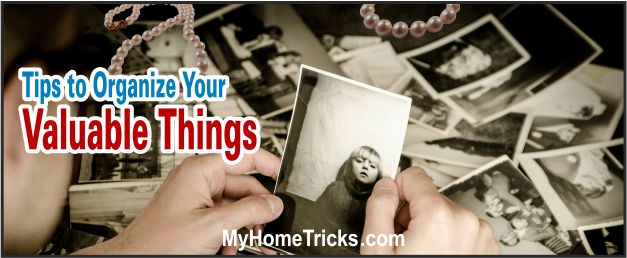Storing Personal Items
Sometimes, we feel chaos at home. When we do not organize our personal belongings correctly, making our home life difficult. The items that require this type of organization are usually books, photographs, jewelry, and tools. However, we can prevent this chaos with simple and small tips. Let’s take a look at these tips that will make our home life easier:
Storing Jewelry
Keep valuable items of jewelry separate so that they do not scratch one another. Put these pieces and items of sentimental value in a safe at home or in a safe-deposit box at a bank. Have jewelry valued for insurance, and inform the insurers if you sell or buy any pieces.
Keeping Small Items:
- Tidying rings: Make a ring post for holding inexpensive rings. Cut a piece of dowel 3 in (7.5 cm) long and attach one end to a wood or cork base. Slip rings onto the post.
- Grouping earrings: To store earrings for pierced ears, stick them into a pincushion.
- Hanging clip-on earrings: Pin a ribbon inside a drawer with thumbtacks. Hang clip-on earrings on the ribbon.
- Collecting items: Use a small tray or box to hold accessories that you wear every day. Make a habit of putting these accessories into the tray at night, so you will be sure to find them in the morning.
Storing Necklaces:
- Arranging necklaces: Keep inexpensive necklaces in a long box or poster tube, or loop them onto a coat hanger, and hang them in a closet.
- Attach a cup hook to the inside of an armoire door. Store an inexpensive necklace or bracelet by hanging it on the cup hook.
Organizing Books and Papers
The writer John Milton said, “A good book is the precious lifeblood of a master spirit.” Well-kept books give years of pleasure. Mark your place with a bookmark instead of folding the corners of pages. When you lend a book, note its title and the name of the borrower.
Planning Storage:
- Setting up a system: Group your books into categories. For example, arrange them alphabetically by the authors’ surnames, or by subject matter.
- Allowing room: Leave at least 1 in (2.5 cm) between the tops of the books and the base of the shelf above so that you can remove books easily. Allow at least 1 in (2.5 cm) of shelf width for every book.
- Arranging sheet music: Use a magazine rack to hold small quantities of sheet music. Sort large collections alphabetically and allocate a shelf for them.
Preserving Books:
- Minimizing humidity: Keep books in dry places. Combat humidity by putting a small moisture absorber near places that attract condensation, such as double-glazed windows.
- Caring for covers: Protect paperbacks with plastic jacket covers. Wipe leather bindings with leather cleaner.
- Keeping down dirt: Remove books regularly and dust them and the bookshelves.
- Making dust shields: Tack 2-in (5-cm) wide leather strips to the fronts of shelves to keep dust off the books beneath.
Organizing Photographs and Films
In recent years, almost no one has used a film camera anymore. However, this article may still be useful for the few who use them. Additionally, very few people have their photos printed on paper, but those who do may need information on how to protect those photos. While it is known that digitally stored photographs do not last very long, this section of the article may be of use to a limited number of people as memories are not valued as much as they used to be.
- Photographs are precious mementos: Store them in a cool, dry place to protect them from damage. Keep any that have particular value in a fireproof box or safe, or leave copies in the bank. Group photographs in boxes or albums to keep them neat and accessible.
- Labeling prints: If prints or packages do not already have a date, write the month and year on the back of each print, along with the location.
- Arranging Prints Neatly: Store prints in shoeboxes instead of putting them in an album. To find photographs quickly, create a filing system using index cards as dividers. Label the cards to show the contents of each section.
Dealing with Films:
• Keeping undeveloped film: Heat damages film, so keep rolls in a refrigerator. Place them in a covered rack in the door, well away from food.
• Storing exposed film: Put undeveloped rolls back in their original containers, and keep them in a cool, dark place. Put negatives in the package in which they were returned.
• Developing film: Have the film developed as soon as possible after using up a roll. If the film is left for a long time, the images may deteriorate.
• Taking films on vacation: In hot weather, wrap your camera and film in a plastic bag, and keep them in a cooler to protect them from dust and heat.
• Avoiding marks: Handle negatives carefully, touching only the edges. Do not leave fingerprints on them because this will result in poor reprints.
• Filing negatives neatly: To store negatives flat, keep them in their plastic sleeves. Punch holes in the sleeves, take care to avoid the negatives and file in a ring binder. Label each sleeve to indicate the contents.
Storing Tools
Garden and household tools are expensive, so take care of them to prolong their useful lives. Keep implements with blades in a safe place, out of reach of children, and with the blades sheathed in thick cloth or bubble wrap.
Keeping Implements:
• Hanging tools: Protect tools from damage by hanging them up. Keep them on hooks or on a metal or wooden rack. If a tool has no hole by which to hang it, drill a hole in the handle, thread string through it, and tie it to form a loop.
• Storing small items: Use plastic storage boxes to keep garden items such as trowels and household implements such as wrenches and drill bits.
• Maintaining implements: Clean all tools after you have used them. Wash dirty garden tools under an outside faucet, then dry them carefully.
• Storing for a season: At the end of the gardening season, clean all tools thoroughly. Oil metal parts to prevent rusting and protect unpainted wood by rubbing it with linseed oil.
Storing Large Items:
• Storing a wheelbarrow: Prop the barrow up against a wall. Put a brick in front of the wheel, and fix the handles to the wall with bungee cords.
• Keeping a hose: Punch four holes in the base of an old enamel basin, and screw it onto a large board. Screw the board to one wall of a garage or shed, then wrap the hose around the basin to keep it neat.
Clearing a Workshop:
• Utilizing work surfaces: Keep work surfaces clean and clear so that they are ready for use. Use shelves or spaces under work surfaces for storage.
• Making a tool board: Wrap tools in plastic wrap and lay them on a board. Attach nails where the tools are to hang. Spray the tools and board with paint and let dry. Unwrap the tools, then hang them in the marked places.






